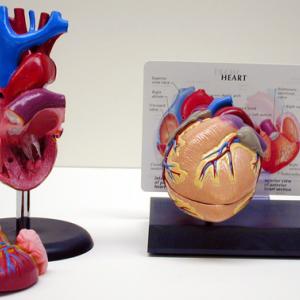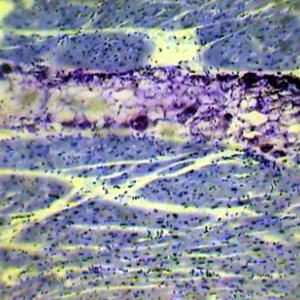College of Liberal Arts & Sciences
11A10.30 - Model of the Human Heart
No advanced notice required. Parts of the heart are numbered and an explanation of these parts can be found in the file.
- Erica Farnsworth, Mark A. Milanick, "ECG Voltage and Vector Analysis for Heart Axis Determination", Vol. 59, #9, Dec. 2021, p. 720.
- Prabasaj Paul and Laurel B. Symes, "Ballistocardiography in the Physics Classroom", TPT, Vol. 46, #5, May 2008, p. 300.
- Corissa Thompson and Arne Troelstra, "Signal Enhancement in the Presence of High Noise Levels—The Electrocardiogram", TPT, Vol. 34, #7, Oct. 1996, p. 418.
- Doug Fox, "Pacemaker Postscript", TPT, Vol. 24, #9, Dec. 1986, p. 527.
- H. Richard Crane, "Some of the Physics of Cardiac Pacemakers", TPT, Vol. 24, #4, Apr. 1986, p. 248.
- H. Richard Crane, "How To Pump Blood Without A Heart", TPT, Vol. 22, #4, Apr. 1984, p. 252.
- Dr. Finck, "Measuring the Heartbeat of a Spider", TPT, Vol. 19, #5, May 1981, Back Cover of the May Issue.
- James M. Reynolds, "Electrocardiography Electrode Placement", TPT, Vol. 11, #9, Dec. 1973, p. 561.
- Pierre Lafrance, "The Electrocardiograph — Teaching Physics to Premeds", TPT, Vol. 10, #8, Nov. 1972, p. 462.
- Harold Metcalf, "Electrocardiography for Freshman", TPT, Vol. 10, #2, Feb. 1972, p. 98.
- Mituo Uehara, Kumiko K. Sakane, and Simone A. Bertolotti, "Thermodynamics of the Heart: Relation Between Cardiac Output and Oxygen Consumption", AJP, Vol. 76, #6, June 2008, p. 566.
- P. B. Siegel, A. Urhausen, J. Sperber, and W. Kindermann, "Putting Your Heart Into Physics", AJP, Vol. 72, #3, Mar. 2004, p. 324.
- Mituo Uehara and Kumiko K. Sakane, "Physics of the Cardiovascular System: An Intrinsic Control Mechanism of the Human Heart", AJP, Vol. 71, #4, Apr. 2003, p. 338.
- Johanna Miller, "The Subtle Math of a Heartbeat Gone Wrong", Physics Today, Vol. 76, #3, March 2023, p. 18.
- Shelley McKellar, "Atomic Hearts: A Decade of US Government-Sponsored Development", Physics Today, Vol. 69, #5, May 2016, p. 38.
- Alain Karma and Robert F. Gilmour Jr., "Nonlinear Dynamics of Heart Rhythm Disorders", Physics Today, Vol. 60, #3, Mar. 2007, p. 51.
- A. Lee, A. R. Hudson, D. J. Shiwarski, J. W. Tashman, T. J. Hinton, S. Yerneni, J. M. Bliley, P. G. Campbell, and A. W. Feinberg, "3D Bioprinting of Collagen to Rebuild Components of the Human Heart", Science, Vol. 365, #6452, Aug. 2019, p. 482.
- Caroline Delbert, "After 500 Years, a Mathematical Principle Has Unlocked Leonardo da Vinci's Human Heart Mystery", Popular Mechanics, March/April 2021, p. 18
- "Bloodstream", Uncle John's Bathroom Reader, p. 137.
- Harvard Instructional Physics Labs, "Lab 5: Acoustic Signals and the Heart"
- Janice Vancleave, "20. The Pump", The Human Body for Every Kid, p. 151 - 157.
- Janice Vancleave, "79. Squeezed", Janice VanCleave's 203 Icy, Freezing, Frosty, Cool, and Wild Experiments, p. 45.
- Janice Vancleave, "78. Heartbeat", Janice VanCleave's 203 Icy, Freezing, Frosty, Cool, and Wild Experiments, p. 44.
- Janice Vancleave, "77. Lub-Dub", Janice VanCleave's 203 Icy, Freezing, Frosty, Cool, and Wild Experiments, p. 44.
- "Giant Heart Exhibit", How It Works, Spring 2001 Science Supplement, p. 294.
- David Blackman, "Thermodynamic Elements of the Myocyte", May 30, 2004.
- Curt Suplee, "Of Heart Attacks and Brain Attacks", Everyday Science Explained, National Geographic, p. 230 - 321.
- Curt Suplee, "Born to Beat", Everyday Science Explained, National Geographic, p. 228 - 229.
- Sara Stein, "You Can't Hear a Heart Beat", The Science Book, p. 124.
- Julius Sumner Miller, Q69 & A69, Millergrams I – Some Enchanting Questions for Enquiring Minds, p. 45 & 101.
Disclaimer: These demonstrations are provided only for illustrative use by persons affiliated with The University of Iowa and only under the direction of a trained instructor or physicist. The University of Iowa is not responsible for demonstrations performed by those using their own equipment or who choose to use this reference material for their own purpose. The demonstrations included here are within the public domain and can be found in materials contained in libraries, bookstores, and through electronic sources. Performing all or any portion of any of these demonstrations, with or without revisions not depicted here entails inherent risks. These risks include, without limitation, bodily injury (and possibly death), including risks to health that may be temporary or permanent and that may exacerbate a pre-existing medical condition; and property loss or damage. Anyone performing any part of these demonstrations, even with revisions, knowingly and voluntarily assumes all risks associated with them.

